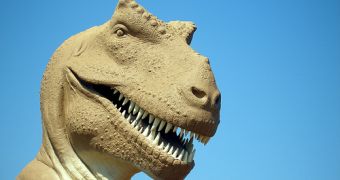Paleontologists from the United States and Canada have found traces on Tyrannosaurus Rex fossils suggesting that besides eating other dinosaurs, the behemoth also ate each other.
Nick Longrich, researcher at Yale, was carrying out a study on dinosaur bones with tooth marks on them, and as he was looking through several dinosaur fossil collections, he found a bone that had very large traces on it.
After considering the age and location of the fossil, he concluded that the marks were made by T-Rex , because “they're the kind of marks that any big carnivore could have made, but T. Rex was the only big carnivore in western North America 65 million years ago.”
It was not until after attributing the marks to a T-Rex, that the researcher realized the bitten bone also belonged to the same species.
So Longrich started analyzing other T-Rex bones, several dozens to be more precise, from different museum fossil collections, and he discovered three foot bones and one arm bone that underwent T-Rex cannibalism.
He was surprised by how frequent the traces were and added that “we're not exactly sure what that means.”
An analysis of the marks says that these are definitely caused by feeding but Longrich said that scientists aren't sure whether they are the result of scavengers or the end result of fighting.
There is a possibility that if two T-Rex fought to death, the winner could have turned its former adversary into a meal.
“Modern big carnivores do this all the time,” Longrich said.
“It's a convenient way to take out the competition and get a bit of food at the same time.”
Until now, only one other dinosaur species was known to be cannibals – Majungatholus, but Longrich said that this was even more common than we would imagine, and that a more thorough examination of fossil bones could prove that there were many other species that ate each other.
The discovery is even more impressive as T-Rex hunted on their own, and not in packs like today's large carnivores.
“These animals were some of the largest terrestrial carnivores of all time, and the way they approached eating was fundamentally different from modern species.
“There's a big mystery around what and how they ate, and this research helps to uncover one piece of the puzzle.”
The new study was published online in the journal PLoS ONE.

 14 DAY TRIAL //
14 DAY TRIAL //